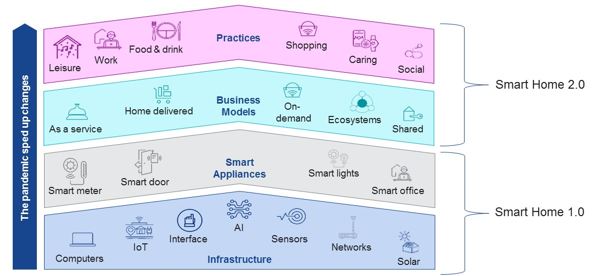Tomorrow's smart home 2.0 will transform lives
13 April 2022
Share with a Friend
All fields required where indicated (*)In the past, when people envisioned a smart home, they would often paint a picture of a smart refrigerator that would restock itself. Today, a smart home is often synonymous with a house equipped with smart gadgets that automate functions such as heating, lights, security or entertainment. In the future, however, our homes will ‘understand’ us: combining technology and data sources to create smart living concepts. Smart lights, energy systems and doorbells are only the first stage of the smart home. Eventually, the technology in our smart homes will move to the background and become ambient.
Smart home 1.0 is building an infrastructure for automation
We can now automate a growing number of home domains, ranging from lights, heat and security to entertainment systems — and operate these devices with an app or voice assistant. To show people what is possible, companies such as Control4 and Gira are even creating smart home showrooms, where people can experience how these homes could enhance their lives. Impressive as these showrooms may be, the solutions they portray are still located in the two lower layers of the smart home stack (see diagram). At this moment, however, the appliances in these layers often do not work together to create the optimal experience for residents. They are the first, 1.0, version of the smart home.
Technology Enables The Smart Home

Source: Dasym
Smart home 2.0 will be an intelligent ecosystem, not a clever gadget
Fortunately, work is already underway to break open the home automation silos, paving the way for the smart home’s version 2.0. Whereas smart home 1.0 mostly creates closed silos, this second version connects in-home systems with activities across the areas of daily life, adding value in fundamental ways like living a healthy life with good food and enough exercise.
On a technological level, smart home standards such as Matter will enable residents to buy any smart home appliance and connect it to their existing ecosystem (e.g. Google Home, Samsung SmartThings, see previous blog). But there’s also innovation at the business level. As the stack shows, the smart home 1.0 infrastructure serves as a foundation for new business models, which some companies are already working on.
Amazon, for instance, is creating a valuable service that helps people to “age in place”. Their Care Hub ecosystem (also discussed in our blog on healthcare) consists of smart home devices such as voice speakers, alarm systems, smart doorbells (to assist with medication delivery), fall detection devices and even a rolling robot. Besides, its new subscription service, Alexa Together, makes it easier for relatives to stay in touch and offers remote monitoring with proactive features.
Yet smart home business models are not limited to technology companies. Insurers, such as Hippo, are innovating around smart living concepts as well, providing devices (e.g. smoke detectors, alarm systems) that can prevent or minimize damage and lower the number of claims.
Chinese appliance manufacturer, Haier, is taking the smart home 2.0 to a truly new level. Its ‘Three Winged Bird’ concept uses scenarios around health, food, clothing and entertainment to connect Haier devices with partner solutions in each domain. Clothing, for example, not only contains Haier washing machines, but also oversees the entire life cycle of clothing, including purchases, repair, storage and styling. To provide this, Haier has allied with more than 40 strategic partners in the clothing domain, including apparel, detergent and home textiles companies. Moreover, it has established a laundry alliance with approximately 3,000 offline stores.
You won’t notice the clever gadgets in tomorrow’s smart homes
While we often envision a smart home as a house full of fancy gadgets, this might be over-stated. Instead, it is more likely the technology moves to the background with ambient control. Ambient computing at home promises to free us from app and voice control. This broad term describes an environment of smart devices, data, AI and human activity that enables computer actions alongside everyday life. Simply said, everything should just work, because our ambient home will use AI to learn our preferences and figure out what’s needed in any given moment. As a result, the ambience of our home will shift, based on the context and function it is facilitating at any given moment.
Nevertheless, to create a truly ambient smart home, we will need something like the introduction of the App Store and the iPhone in 2007. This combined a technological innovation (the iPhone) with an economic innovation (the App Store) and heralded the era of the smartphone. The current smart home landscape, however, is comparable with the period of feature phones, with some smart phones (the smart living services from Amazon and Haier) just emerging. Experiments with ambient homes are only just beginning. These experiments, however, show that an ambient home might come sooner than we expect.
Important Disclosure
Sign-up for our ETF newsletter